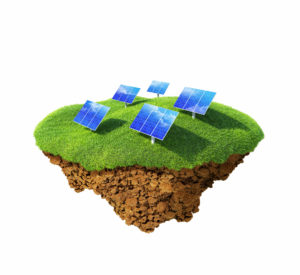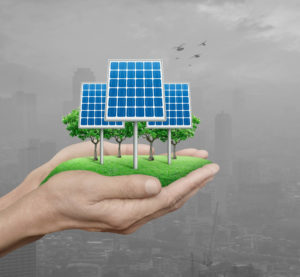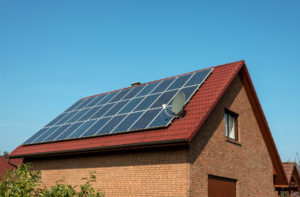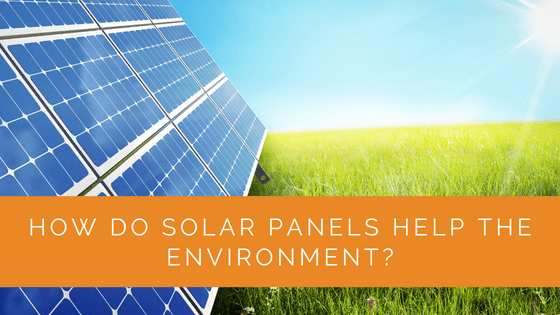Solar panels offer a solution to air pollution caused by vehicular emissions, coal-based power plants, and industrial processes. With momentum in both residential and commercial applications, they reduce our reliance on fossil fuels, improve air quality, reduce hazardous waste, and mitigate water pollution. Let’s explore the technology and installation options available, paving the way for a brighter and more sustainable future. Harnessing solar energy is an ancient idea that continues to light our path toward a cleaner and greener tomorrow.
Contents
- 1 Key Takeaways
- 2 Role Solar Panels Play in Reducing Air Pollution
- 3 How Solar Panels Lower the Need for Non-Renewable Energy Resources
- 4 Solar Panels Reduce Hazardous Waste
- 5 Reducing Water Pollution
- 6 The Mechanism Behind Solar Panels
- 7 Solar Panel Installation
- 8 Case Study: Solar Panel Installation and its Environmental Impact
- 9 Expert Insights From Our Solar Panel Installers About How Solar Panels Help the Environment
- 10 Experience Solar Excellence with Us!
- 11 Nothing New Under the Sun
Key Takeaways
- Solar panels reduce air pollution by decreasing dependency on fossil fuels for electricity production, leading to improved air quality.
- Solar power harnesses a vast, renewable energy source, reducing the need for non-renewable energy resources and promoting sustainability.
- Solar panels naturally lower hazardous waste production associated with fossil fuel power plants, contributing to environmental preservation and reducing health risks.
Role Solar Panels Play in Reducing Air Pollution
It is incredibly tragic to think that clean air is in short supply. Some primary causes of air pollution include vehicular emissions, power plants fuelled by coal, chemical production, manufacturing processes, and the natural gas and oils used to heat homes.
Besides a rise in carbon footprint, which contributes to global warming, these sources also emit sulfur and nitrogen dioxide. The former is responsible for increased acid rain, whereas the latter is the leading cause of smog.
The sun’s power is a renewable energy resource. As solar energy becomes more popular, both in terms of residential solar panels as well as commercial ones, energy production will depend less on fossil fuels or a utility company.
The air quality index can improve dramatically with a reduced reliance on fossil fuels.

How Solar Panels Lower the Need for Non-Renewable Energy Resources
So, how does solar power lower the dependency on non-renewable energy resources?
It’s vital to remember that solar thermal energy is the most abundant energy source in the world. Forget about kilowatt-hours; the sun can generate an estimated 173,000 terawatts of energy every second!
To put things into perspective, if all solar energy reaching the earth in a single hour could be captured, the world could produce enough electricity to run solely on solar power for an entire year.
As a bonus, even for laypeople, solar panels are way easier to access.
Solar Panels Reduce Hazardous Waste
Adverse environmental impacts caused by coal-fuelled power plants may not be the least of the world’s worries, but they are certainly not the only ones. Such units also release extremely harmful toxic wastes, around millions of tons, into the environment.
These wastes get dumped into nearby landfills, abandoned mines, etc., and can mingle with the air, significantly deteriorating its quality. The locals who live around the waste dumping facilities pay for the total cost of fossil fuel consumption. They may develop terminal conditions such as lung cancer, asthma, and chronic obstructive pulmonary disease (COPD).
Thankfully, solar panels naturally reduce hazardous waste by lowering the need for fossil fuel burning.

Reducing Water Pollution
Water and energy share a somewhat bitter-sweet relationship. Almost all forms of energy generation rely on vast volumes of water (even methods such as biomass and geothermal). Besides, the energy generation process also releases harmful pollutants into the water, polluting it.
Then, a huge kilowatt-hour of energy is required to produce freshwater fit for public use. It’s more like a vicious cycle. Though numerous wet-recirculating plants were set up with water-cooling systems to tackle this issue, they consumed more water (ironically).
It looks like the sun has the solution to this problem, too. Besides being a renewable energy source, solar energy is unique as the photovoltaic cells of panel systems do not require water to generate electricity. Naturally, water is not wasted or polluted.
The Mechanism Behind Solar Panels
Solar panel systems comprise photovoltaic cells that convert the sun’s energy into electricity. These cells are squeezed between layers of semiconductors, most commonly silicon-made.
Each semi-conducting layer possesses electronic properties. When photons from sunlight hit these layers, an electric field is created. This process is called the photoelectric effect, which generates the current that produces electricity.
However, the electricity generated is a direct current. The same passes through an inverter, which converts it into alternating current. From here, the AC is supplied to the National Electric Grid of homes and businesses.

Solar Panel Installation
There are two ways to enjoy the benefits of solar energy – one is to have solar panels installed on the rooftop of your residential or commercial property, and the second is to subscribe to the services of reliable solar companies.
If you choose the former route, remember that many factors regarding solar panel installation go into play. Some of these include the roof’s condition, the slope of the roof for proper water drainage, the weight the roof can withstand, and the property’s energy requirements.
Then, there are monocrystalline and polycrystalline solar panels, each suitable for different needs. Finally, the upfront installation costs of solar panels may seem daunting, but fret not; all initial expenses can be recovered with a long-term reduction in utility bills.
If you cannot afford the upfront costs, contact a reliable solar company offering solar leases. Solar roof panels can be set up with minimal to no initial costs, and you can gradually pay back based on the lease contract terms.
Case Study: Solar Panel Installation and its Environmental Impact
Background
The Coleman family, living in Boise, Idaho, decided to transition to solar energy to reduce their environmental footprint and take advantage of Idaho’s abundant sunlight. Their primary goals were to lower their electricity bills and contribute to a cleaner environment by reducing reliance on fossil fuels.
Project Planning and Objectives
The Coleman family’s objectives included:
- Reducing their monthly electricity bills
- Minimizing their carbon footprint
- Taking advantage of state and federal incentives for solar energy
- Ensuring a reliable and sustainable energy source for their home
They contacted Solar Panels Network USA to assess their home’s suitability for solar panels and to develop a customized installation plan.
Installation and Costs
After a thorough evaluation, a 7kW solar panel system was recommended. The breakdown of costs included:
- Solar Panels: $14,000
- Installation: $3,500
- Inverter and Battery: $2,500
- Permits and Inspections: $1,000
- Total Estimated Cost: $21,000
Financial Incentives:
- Federal Tax Credit (ITC): $6,300
- State Rebates: $2,000
- Adjusted Total Cost: $12,700
Installation Process
The installation process was completed in three days and included the following steps:
- Site Assessment: Evaluating the roof’s condition, slope, and orientation to ensure optimal panel placement.
- Panel Installation: Mounting 24 high-efficiency monocrystalline solar panels on the south-facing roof.
- System Integration: Connecting the panels to a high-efficiency inverter and a battery for energy storage.
- Inspection and Activation: Conducting a final inspection and system activation to ensure optimal performance.
Results and Benefits
The Coleman family’s solar power system now generates approximately 800 kWh per month, covering most of their energy needs and significantly reducing their reliance on the grid. This not only reduced their electricity bills but also provided additional savings through net metering, where excess energy is fed back into the grid.
Environmental and Financial Impact:
- Annual Savings: $1,800
- Payback Period: ~7 years
- Reduced CO2 Emissions: ~3.5 metric tons annually
- Enhanced Energy Independence: The family experiences fewer disruptions and a significant reduction in energy costs.
Summary
The Coleman family’s experience in Boise, Idaho, demonstrates the substantial benefits of transitioning to solar energy. By leveraging Idaho’s abundant sunlight and taking advantage of state and federal incentives, they achieved significant financial savings and reduced their carbon footprint. Solar Panels Network USA’s expertise ensured a smooth installation process, setting a positive example for sustainable living in Idaho. The project highlights the importance of customized solar solutions to maximize environmental and financial benefits for homeowners.
Expert Insights From Our Solar Panel Installers About How Solar Panels Help the Environment
Solar panels play a significant role in reducing air pollution by decreasing our reliance on fossil fuels. By generating clean, renewable energy, we can significantly cut down on emissions from coal and gas power plants.
The environmental benefits of solar panels extend beyond air quality. Solar power reduces hazardous waste from fossil fuel plants, which helps protect both our land and water resources from contamination.
Installing solar panels not only provides immediate environmental benefits but also promotes long-term sustainability. By harnessing the sun’s power, we can create a more resilient energy infrastructure that is less dependent on non-renewable resources.
Experience Solar Excellence with Us!
Trust in Solar Panels Network USA, where our seasoned experts deliver top-quality solar solutions for homes and businesses nationwide. With a legacy of countless successful installations and a commitment to sustainable energy, we’re your reliable partner in the solar journey. Ready for a brighter, eco-friendly future? Call us now at (855) 427-0058 and harness the sun’s power!
Nothing New Under the Sun
Though technological advancements today have streamlined the process of harnessing solar energy, it is far from a novel practice. Ancient Egyptians were the first to use solar energy to heat their homes. That would be as early as the 7th century BC!
It looks like humankind has always had the answer to modern-day complex challenges, and while methodologies may be progressive, it’s all about returning to the roots. The sun is considered to be a life-giving force. So, is it any surprise that it breathes life into the sterile practices of today?
About the Author
Solar Panels Network USA stands at the forefront of solar energy solutions, driven by a team of seasoned solar engineers and energy consultants. With over decades of experience in delivering high-quality solar installations and maintenance, we are committed to promoting sustainable energy through customer-centric, tailored solutions. Our articles reflect this commitment, crafted collaboratively by experts to provide accurate, up-to-date insights into solar technology, ensuring our readers are well-informed and empowered in their solar energy decisions.

